
The Douglas SBD Dauntless is a World War II American naval scout plane and dive bomber that was manufactured by Douglas Aircraft from 1940 through 1944. The SBD was the United States Navy's main carrier-based scout/dive bomber from mid-1940 through mid-1944. The SBD was also flown by the United States Marine Corps, both from land air bases and aircraft carriers. The SBD is best remembered as the bomber that delivered the fatal blows to the Japanese carriers at the Battle of Midway in June 1942. The type earned its nickname "Slow But Deadly" during this period.

The Curtiss SB2C Helldiver is a dive bomber developed by Curtiss-Wright during World War II. As a carrier-based bomber with the United States Navy (USN), in Pacific theaters, it supplemented and replaced the Douglas SBD Dauntless. A few survivors are extant.

The Vought SB2U Vindicator is an American carrier-based dive bomber developed for the United States Navy in the 1930s, the first monoplane in this role. Vindicators still remained in service at the time of the Battle of Midway, but by 1943, all had been withdrawn to training units. It was known as the Chesapeake in Royal Navy service.
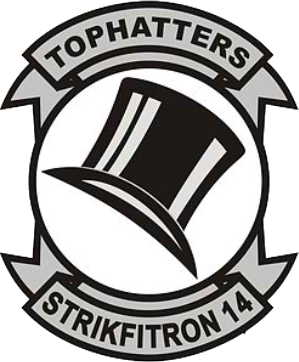
The Strike Fighter Squadron 14 (VFA-14) "Tophatters" are a United States Navy fighter attack squadron based at Naval Air Station Lemoore. They fly the F/A-18E Super Hornet, and are the Navy's oldest active squadron, having formed in 1919. Their callsign is Camelot, and their tail code is NG.

The Curtiss SBC Helldiver was a two-seat scout bomber and dive bomber built by the Curtiss-Wright Corporation. It was the last military biplane procured by the United States Navy. Delivered in 1937, it became obsolete even before World War II and was kept well away from combat with Axis fighters.

A carrier air wing is an operational naval aviation organization composed of several aircraft squadrons and detachments of various types of fixed-wing and rotary-wing aircraft. Organized, equipped and trained to conduct modern US Navy carrier air operations while embarked aboard aircraft carriers, the various squadrons in an air wing have different but complementary missions, and provide most of the striking power and electronic warfare capabilities of a carrier battle group (CVBG). While the CVBG term is still used by other nations, the CVBG in US parlance is now known as a carrier strike group (CSG).

Marine Attack Squadron 231 (VMA-231) is a United States Marine Corps fixed wing attack squadron that consists of AV-8B Harrier (V/STOL) jets. The squadron, known as the "Ace of Spades", is based at Marine Corps Air Station Cherry Point, North Carolina and fall under the command of Marine Aircraft Group 14 (MAG-14) and the 2nd Marine Aircraft Wing.

Attack Squadron 65 (VA-65), nicknamed The World Famous Fighting Tigers, was an attack squadron of the United States Navy. The squadron was established as Torpedo Squadron VT-74 in 1945, redesignated as VA-2B in 1946, as VA-25 on 1 September 1948, and finally redesignated VA-65 on 1 July 1959. It was disestablished in 1993. Known as "The World Famous Fighting Tigers", VA-65 was one of the last medium attack squadrons to fly the A-6 Intruder and the A-1 Skyraider. It was the second squadron to be designated VA-65, the first VA-65 was redesignated from VA-6B on 27 July 1948 and would be redesignated as VA-25 on 1 July 1959.
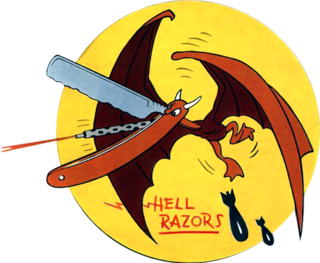
Attack Squadron 174 (VA-174) also known as the "Hellrazors" was a United States Navy attack squadron based at Naval Air Station Cecil Field, Florida, and were attached to Light Attack Wing One. It was commissioned from 1944 to 1988.

Naval Air Station Squantum was an active naval aviation facility during 1917 and from 1923 until 1953. The original civilian airfield that preceded it, the Harvard Aviation Field, dates back to 1910. The base was sited on Squantum Point in the city of Quincy, Massachusetts. It also abutted Dorchester Bay, Quincy Bay, and the Neponset River.

Attack Squadron 75 (VA-75) or ATKRON 75 was an attack squadron of the United States Navy that was active from World War II through the 1990s. Nicknamed the "Sunday Punchers," they were based out of Naval Air Station Oceana, Virginia. Originally established as Bombing Squadron EIGHTEEN (VB-18) on July 20, 1943, it was redesignated Attack Squadron VA-7A on 15 November 1946, redesignated Attack Squadron VA-74 on 27 July 1948, redesignated Attack Squadron VA-75 on 15 February 1950 and disestablished on February 28, 1997. They were the second squadron to be designated VA-75, the first VA-75 was disestablished on 30 November 1949. They were the first fleet squadron to operate the A-6 Intruder and the last unit to fly it in operational service.
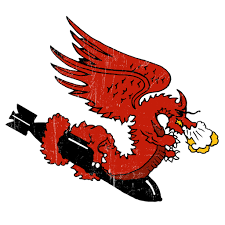
Attack Squadron 35 (VA-35) was an aviation unit of the United States Navy. The squadron's nickname is unknown. Its insignia, a winged dragon, was revised several times during its lifetime. The squadron was first established as Torpedo and Bombing Squadron 2 (VT-2) on 6 July 1925, and was redesignated as VT-2B on 1 July 1927, VT-3 on 1 July 1937, VA-4A on 15 November 1946, and, finally, VA-35 on 7 August 1948. The squadron was disestablished on 7 November 1949. It was the first squadron to carry the VA-35 designation, the second VA-35 was redesignated from VA-34 on 15 February 1950 and disestablished on 31 January 1995.
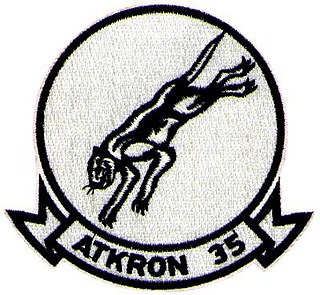
Second VA-35, nicknamed the Black Panthers, was a long-lived Attack Squadron of the U.S. Navy. It was the second squadron to be assigned the VA-35 designation.

VA-94 was an Attack Squadron of the U.S. Navy. It was established as Bombing Squadron VB-99 on 1 July 1943, redesignated as VB-20 on 15 October 1943, and as VA-9A on 15 November 1946. It was finally redesignated as VA-94 on 12 August 1948. The squadron was disestablished on 30 November 1949. Its nickname was Bombing Twenty's Tough Kitty from 1943 to 1946.

VA-114 was an Attack Squadron of the U.S. Navy. It was established as Bombing Squadron VB-11 on 10 October 1942, redesignated VA-11A on 15 November 1946, and finally as VA-114 on 15 July 1948. The squadron was disestablished on 1 December 1949. The squadron was known as the Pegasus.
VA-194 was an Attack Squadron of the U.S. Navy. It was established as Bombing Squadron VB-19 on 15 August 1943. It was redesignated as VA-19A on 15 November 1946, and as VA-194 on 24 August 1948. The squadron was disestablished on 1 December 1949. Its nickname is unknown.
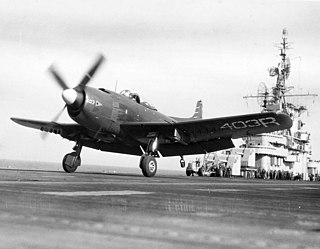
VA-174 was an Attack Squadron of the U.S. Navy. It was established as Bomber Squadron VB-82 on 1 April 1944, redesignated as VA-17A on 15 November 1946, and finally as VA-174 on 11 August 1948. The squadron was disestablished on 25 January 1950. Its nickname throughout its life was the Battering Rams. A second, unrelated, squadron was assigned the VA-174 designation in 1966.

Sea Control Squadron 24 (VS-24) was a squadron of the United States Navy. Originally established as VB-17 on 1 January 1943, it was redesignated as VA-5B on 15 November 1946, redesignated as VA-64 on 27 July 1948, redesignated as VC-24 on 8 April 1949 and redesignated as VS-24 on 20 April 1950, it was disestablished on 1 June 1956. It was however reestablished again before being decommissioned in 2007.
Carrier Air Group Seventeen (CVG-17) was a designation used by the United States Navy to identify two unrelated Carrier Air Groups; the first of which was established on 1 January 1943 as Carrier Air Group Seventeen and disestablished on 1 April 1992 as Carrier Air Wing Six; and the second of which was established as Carrier Air Group Eighty Two on 1 April 1944 and ultimately disestablished as Carrier Air Group Seventeen on 16 September 1968. Neither group shares a lineage with the current Carrier Air Wing Seventeen (CVW-17) as the first was the forerunner of CVW-6 and the second was disestablished eight years before CVW-17 was established.
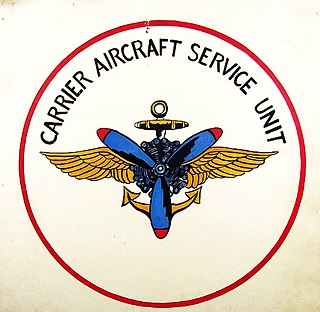
Carrier Aircraft Service Units (CASU) were United States Navy units formed during World War II for the Pacific War to support naval aircraft operations. From 1942 to 1946, 69 Carrier Aircraft Service Units were formed to repair and maintain aircraft. The first unit was deployed to Naval Station Pearl Harbor. The CASU-11, was deployed on January 22, 1943 at Naval Air Station San Diego. During the war the Navy lacked enough aircraft carriers to complete all the operational requirements.



















